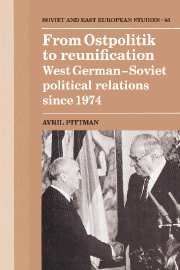Book contents
- Frontmatter
- Contents
- List of tables
- Preface
- Note on text
- Chronology
- Introduction
- 1 The Second World War and its aftermath, 1945–1974
- 2 Ethnic Germans
- 3 Berlin
- 4 The Federal Republic of Germany's relations with the German Democratic Republic
- 5 INF, Afghanistan and the post-Afghanistan period
- 6 Assessment of the Federal Republic of Germany's relations with the Soviet Union, 1974–1982
- 7 The Federal Republic of Germany's political relations with the Soviet Union after 1982
- Appendices
- Notes
- Bibliography
- Index
- Series list
1 - The Second World War and its aftermath, 1945–1974
Published online by Cambridge University Press: 12 October 2009
- Frontmatter
- Contents
- List of tables
- Preface
- Note on text
- Chronology
- Introduction
- 1 The Second World War and its aftermath, 1945–1974
- 2 Ethnic Germans
- 3 Berlin
- 4 The Federal Republic of Germany's relations with the German Democratic Republic
- 5 INF, Afghanistan and the post-Afghanistan period
- 6 Assessment of the Federal Republic of Germany's relations with the Soviet Union, 1974–1982
- 7 The Federal Republic of Germany's political relations with the Soviet Union after 1982
- Appendices
- Notes
- Bibliography
- Index
- Series list
Summary
Allied wartime co-operation was born out of the need to defeat the Axis Powers, Anglo-Russian military co-operation beginning in June 1941 when Germany attacked the Soviet Union, and the United States becoming the Soviet Union's ally after the attack on Pearl Harbor. Internal strains were present based on mutual mistrust and Allied differences over the nature and form of a postwar Germany and Europe. These differences, however, were largely subdued and concealed due both to the need to defeat the Axis and to reach Allied agreement.
The Allies met three times at the conferences of Teheran (28 November–1 December 1943), Yalta (4–11 February 1945) and Potsdam (17 July–2 August 1945) which resulted in the following territorial provisions: the eastern part of Poland was given to the Soviet Union; East Prussia was divided up and the southern half put under Polish, the northern area under Soviet administration; and the Oder-Neisse river was declared the provisional border between Germany and Poland pending a peace treaty and final settlement. The Oder-Neisse border meant the loss of German territory to Poland comprising Danzig, large parts of Silesia and Pomerania, and part of Brandenburg and entailed the expelling of 7 million Germans from these areas.
The remainder of Germany was temporarily, i.e. pending a final settlement, divided into four zones of military occupation, and allotted to the Allies, including France. A Four Power control council, the Allied Control Council, was set up to co-ordinate affairs during the occupation period. Berlin, an enclave within the Soviet zone of occupation, was set aside as a special area and divided into four zones under joint administration.
- Type
- Chapter
- Information
- From Ostpolitik to ReunificationWest German-Soviet Political Relations since 1974, pp. 5 - 12Publisher: Cambridge University PressPrint publication year: 1992

